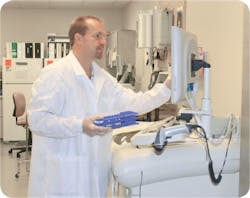Physician office laboratories (POLs) appear to be a
win-win for patients, physicians, and lab techs. As an integral part of a
physician’s practice, POLs provide convenience and lower costs for patients;
quick test results for the physician; and a less-hectic work environment for
technicians.
Under current federal regulations, all clinical
laboratories must be registered with the Centers for Medicare and Medicaid
Services (CMS). In order to qualify as a POL, the practice must be operated
by individual healthcare providers or must be part of a legally constituted,
independently owned and managed partnership or group practice.
While reimbursements from Medicare, Medicaid, and private
insurance companies have dropped in recent years, POLs still can add to the
profitability of a practice.
Early returns
Todd Norris says setting up a physician office lab from
scratch was a “once in a lifetime experience.” After working in a hospital
lab for 15 years, Norris is now the lab manager at Nephrology Associates in
Chattanooga, TN. With a main office and a satellite office, Nephrology
Associates employs 15 physicians and three nurse practitioners. The lab
staff consists of Norris plus one full-time MLT; one part-time MLT; and four
full-time phlebotomists.
Yet, even with a relatively small staff, Norris says his
lab runs between 80 and 100 chemistry panels a day, as well as the same
number of CBCs and dipstick urines. Immunochemistry tests range from 60 to
75 per day, and the lab does about two dozen occult blood tests a day, he
says. Until the lab became fully operational in June of this year, the
practice had been sending all of its specimens to LabCorp. The only tests
being sent out now are those for vitamin D (410 per month), urine cultures
(10 per day), and coagulation tests (six per month).
Norris says the driving force behind setting up this lab
was the physicians wanting test results in their hands at the time they were
seeing patients. “The doctors had a plan to have patients drawn one hour
before seeing their appointments,” he explains. “Previously, patients would
come in one week prior to their appointment. Now, the doctors are very
pleased with getting results in an hour.”
The practice installed a new electronic medical record
(EMR) and a new laboratory information system (LIS), which led to some early
challenges, Norris admits. “Because the EMR is driven by templates, we had
problems getting urinalysis results to cross over, because there was no
place for those to go.”
Being a start-up lab, four new analyzers were purchased,
and Norris says the practice is considering buying a vitamin D analyzer. But
with a $90,000 price tag, return-on-investment has become a stumbling block.
Having worked in a hospital lab, Norris says a POL is
different in some ways. “Our lab is small enough that physicians can come in
here and say, ‘I need an iron add-on.’ Also, things do not get lost between
shifts.”
A typical day in this lab begins at 6 a.m. when the
analyzers are checked and calibrated. “By 7:30 we are ready to run
patients,” he says. Doctors start seeing patients at 8:30 a.m. The lab’s
second MLT arrives at 9:30 and stays until 5:30 p.m. “The last appointment
for doctors is 4 p.m.,” Norris says. InterMed’s lab employs five
technologists and seven phlebotomists, and runs two shifts: 7 a.m. to 3:30
p.m. and 9:30 a.m. to 6 p.m. There is an overlap, since one tech starts at 1
p.m. and stays until the lab closes at 9:30 p.m., Cole says. The lab is not
open on weekends.
Meeting the demand
Kathy Cole, lab manager at InterMed in Portland, ME, says
before the doors of this 60-physician multispecialty practice open at 7
a.m., all analyzers have been calibrated and quality-control checks run. At
7 a.m., blood and urine samples are collected from patients at three
locations in town. Those not coming from patients at the main lab are sent
by courier to the main lab for testing, so all results are available to
physicians within 24 hours, Cole says. STAT results are generated within one
hour, and most other results are available by the end of the day, she says.
And because the practice has invested in both an EMR and LIS, orders and lab
results flow freely between the systems.
CLIA-certified and College of American Pathologists- or
CAP-accredited, InterMed’s lab runs a million tests a year, Cole says.
“Among the tests we run are basic chemistry tests, special chemistry tests,
TSH, PSA, T4, and hormone levels. We also run hematology, coagulation,
urinalysis, hemoglobin, A1c, and limited microbiology. What we do not do
in-house, we send out,” she says.
As for cost effectiveness, Cole says not only has her lab
become “very financially lucrative” but also has proven to be beneficial to
patients. “Our fee schedule is less than what a patient would pay at a
hospital or reference lab,” she says. To improve efficiencies and patient
testing, the lab recently purchased a hematology analyzer which Cole says
can run 100 to 150 CBCs a day. In 2010, she plans to purchase a vitamin D
analyzer so those tests can be run in-house.
Growing more efficient
Richard Kent, lab manager at the Elkhart Clinic in
Elkhart, IN, says his 50-physician multispecialty practice has had an
in-house lab for about 35 years and has grown as the practice has grown.
The lab recently purchased an integrated chemistry
system, which, according to Kent, will allow the lab to run more tests
without having to hire another full-time tech. “This analyzer gives us
additional capacity for routine and EIA (enzyme immunoassay) testing.” It
also will allow the lab to do hepatitis panels and amylase testing that had
previously been sent to a reference lab, he says.
A new dedicated bench-top hemoglobin analyzer also has
eliminated wet chemistry batching as it can process 10 patients in half an
hour, Kent says. The lab also is considering buying a vitamin D analyzer
because the practice sees a large number of patients with osteoporosis, he
adds.
Kent says his full-time staff of 18 draws about 60,000
patients a year and runs approximately 750,000 chemistry, EIA, and
hematology tests per year. Some EIA and polymerase chain reaction, or PCR,
tests, as well as those for HIV and all microbiology tests, are sent to a
reference lab.
Because this lab is open from 7 a.m. to 5 p.m., Monday
through Friday, patients begin coming in at 7 a.m. Fasting patients,
especially those with or suspected of having diabetes, are drawn first, Kent
says.
The lab then starts processing the samples, and a basic
metabolic profile is ready in less than an hour. Thyroid tests can take up
to an hour. “The sooner the physician gets the results, the sooner he can
make needed treatment changes,” Kent says.
Since the practice has both an EMR and LIS, physicians
generally order lab tests for most patients as soon as the patient leaves.
Test results are automatically sent back to the EMR where they can be read
by the physician.
Rather than waiting until the day they are scheduled to
see their doctor, the majority of patients are asked to report to the lab a
day or two before their appointment, Kent says. If there is any challenge
facing Kent right now, it is “trying to stay on top of physicians’ needs and
to keep up with demand while balancing all that against the financial side.”
Richard R. Rogoski is a freelance journalist based in
Durham, NC. Contact him at [email protected] .


